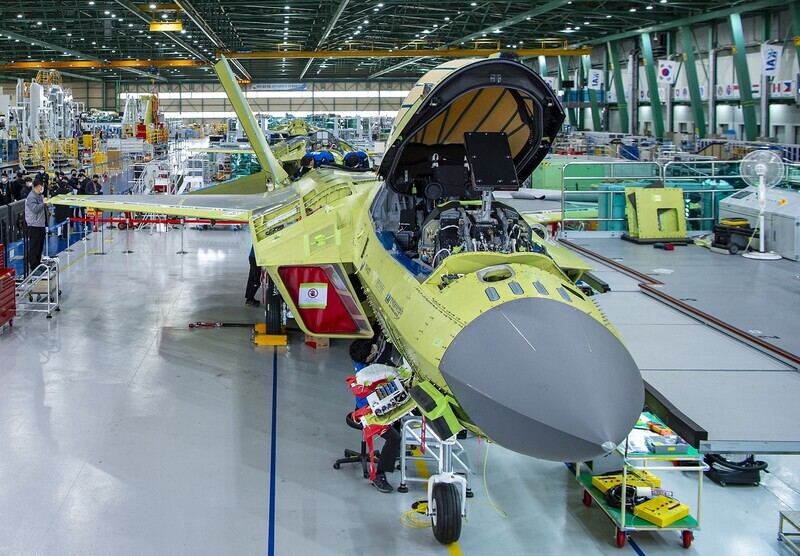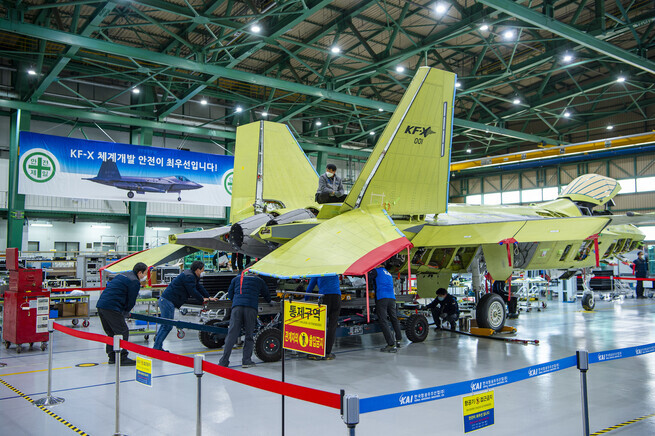hankyoreh
Links to other country sites 다른 나라 사이트 링크
First prototype of KF-X fighter jet to be unveiled next month

On the afternoon of Feb. 24, technicians at the fixed-wing aircraft development hanger of Korea Aerospace Industries (KAI) were busy working on the prototype of the KF-X South Korean fighter jet, which is scheduled to be launched in April. Located in Sacheon, South Gyeongsang Province, the hanger is a sprawling building that covers more than three football fields, with an area of 21,600 square meters (5.3 acres).
The prototype’s fuselage bristles with devices, parts, and cables, presenting a formidable image of a fighter aircraft. Six or seven people stood underneath the fuselage with a small cart, focused on an explanation that involved a lot of hand gestures.
“Now that we’ve completed the engine installation test, we’re removing the engine to paint the fuselage. Once painting wraps up next week, the fuselage will take on a dark gray hue,” a KAI staffer said. The engine is being removed to prevent contamination while the plane is being painted and will be reinstalled afterward, the staffer explained.
South Korea’s Defense Acquisition Program Administration (DAPA) and KAI plan to put on quite a show for the launch of the KF-X prototype in April. A “media day” event was held on Feb. 24 for the domestic press, in which officials presented the results of the development project to date.
The KF-X project began in 2015, when the South Korean government earmarked 8.8 trillion won (US$7.12 billion) to develop a jet fighter that could be the future workhorse of the Republic of Korea (ROK) Air Force, replacing the aging F-4 and F-5 fighters. KAI is leading this international joint R&D project and contributing 20% of the cost, with the South Korean government paying 60% of the cost and the Indonesian government paying the remaining 20%.
The launch of the prototype represents the first tangible results of a promise made about 20 years before. During a commissioning ceremony for graduates of the Korea Air Force Academy in March 2001, former president Kim Dae-jung announced that South Korea would develop a top-of-the-line fighter. Actual confirmation of the long-term need for a new aircraft came 18 years ago, in a meeting of the Joint Chiefs of Staff in November 2002.
Jung Gwang-seon, head of DAPA’s KF-X project team, described the significance of the prototype launch as follows. “This will be a monumental event when Korea’s first fighter is unveiled. From the perspective of the developers, this is a crucial time when a fighter that had only existed in plans becomes a reality and we move into the phase of testing the performance of our research.”

The KF-X is larger than the F-16 but smaller than the F-15, measuring 11.2 meters (36 feet) across and 16.9 meters (55 feet) long. It’s equipped with the latest sensors, including AESA radar (standing for active electronically scanned array), infrared search and track (IRST) equipment, and an electro-optical targeting pod (EO TGP). That gives it the ability to “see first and shoot first,” a requirement on the modern battlefield.
The fighter has 10 weapon stations, with three on each wing and four under the fuselage. The stations can hold a range of cutting-edge weapons, including air-to-air missiles and air-to-surface missiles, weighing up to 7.7 tons. The plane is also equipped with a 20mm Vulcan cannon.
While not exactly a stealth fighter, the KF-X does have a basic stealth profile. That leaves open the option of evolving the design into a fifth-generation fighter through the application of full-fledged stealth technology.
“Becoming a stealth fighter is about more than the shape; we’d also have to develop more technology including radar-absorbing paints and internal weapon bays. In the future, we’ll look into the option of continuing to develop and apply related technology from a long-term perspective,” a KAI staffer said.
Once fighter development is complete, 120 aircraft will be supplied to the ROK Air Force. In exchange for its financial contribution, Indonesia will receive one prototype and technological data, which it will use to build 48 aircraft in local facilities. But Indonesia hasn’t kept up with its financial payments, prompting concerns that the KF-X project may be in trouble.
DAPA reported to the National Assembly’s National Defense Committee last month that of the 831.6 billion won (US$753.1 million) that Indonesia was supposed to pay through February, it had only paid 227.2 billion won (US$205.7 million), leaving 604.4 billion won (US$547.3 million) unpaid. Indonesia had agreed to pay its total contribution of 1.76 trillion won (US$1.57 billion), representing 20% of the project cost, in several stages.
In a statement addressing the controversy, DAPA said that “the Indonesians have expressed their commitment to continued participation in the KF-X development program” and that “the two countries have been seeking a mutually beneficial arrangement through several rounds of working-level negotiations.”
“Indonesia appears to be having a hard time keeping up with its payment plan because of the coronavirus and its economic recession. While the goal of our deliberations is to move forward together if at all possible, the project would certainly not be halted even if Indonesia were to withdraw,” said Jung Gwang-seon, head of the DAPA project team, on Monday.
By Park Byong-su, senior staff writer
Please direct comments or questions to [english@hani.co.kr]

Editorial・opinion
![[Column] Park Geun-hye déjà vu in Yoon Suk-yeol [Column] Park Geun-hye déjà vu in Yoon Suk-yeol](https://flexible.img.hani.co.kr/flexible/normal/500/300/imgdb/original/2024/0424/651713945113788.jpg) [Column] Park Geun-hye déjà vu in Yoon Suk-yeol
[Column] Park Geun-hye déjà vu in Yoon Suk-yeol![[Editorial] New weight of N. Korea’s nuclear threats makes dialogue all the more urgent [Editorial] New weight of N. Korea’s nuclear threats makes dialogue all the more urgent](https://flexible.img.hani.co.kr/flexible/normal/500/300/imgdb/original/2024/0424/7317139454662664.jpg) [Editorial] New weight of N. Korea’s nuclear threats makes dialogue all the more urgent
[Editorial] New weight of N. Korea’s nuclear threats makes dialogue all the more urgent- [Guest essay] The real reason Korea’s new right wants to dub Rhee a founding father
- [Column] ‘Choson’: Is it time we start referring to N. Korea in its own terms?
- [Editorial] Japan’s rewriting of history with Korea has gone too far
- [Column] The president’s questionable capacity for dialogue
- [Column] Are chaebol firms just pizza pies for families to divvy up as they please?
- [Column] Has Korea, too, crossed the Rubicon on China?
- [Correspondent’s column] In Japan’s alliance with US, echoes of its past alliances with UK
- [Editorial] Does Yoon think the Korean public is wrong?
Most viewed articles
- 1‘We must say no’: Seoul defense chief on Korean, USFK involvement in hypothetical Taiwan crisis
- 2[Reportage] On US campuses, student risk arrest as they call for divestment from Israel
- 3[Column] Park Geun-hye déjà vu in Yoon Suk-yeol
- 4‘Weddingflation’ breaks the bank for Korean couples-to-be
- 5Korea sees more deaths than births for 52nd consecutive month in February
- 6N. Korean delegation’s trip to Iran shows how Pyongyang is leveraging ties with Moscow
- 7Amnesty notes ‘erosion’ of freedom of expression in Korea in annual human rights report
- 8Will NewJeans end up collateral damage in internal feud at K-pop juggernaut Hybe?
- 9N. Korean hackers breached 10 defense contractors in South for months, police say
- 10[Guest essay] The real reason Korea’s new right wants to dub Rhee a founding father